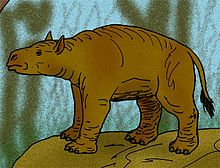| Xenungulata | |
|---|---|

| |
| Interpretation of Carodnia vieirai | |
| Scientific classification | |
| Domain: | Eukaryota |
| Kingdom: | Animalia |
| Phylum: | Chordata |
| Class: | Mammalia |
| Infraclass: | Placentalia |
| Clade: | †Meridiungulata |
| Order: | †Xenungulata Paula Couto 1952 |
| Family and genera[3] | |
Xenungulata ("strange ungulates") is an order of extinct and primitive South American hoofed mammals that lived from the Late Paleocene to Early Eocene (Itaboraian to Casamayoran in the SALMA classification). Fossils of the order are known from deposits in Brazil, Argentina, Peru,[4] and Colombia. The best known member of this enigmatic order is the genus Carodnia, a tapir-like and -sized animal with a gait similar to living African elephants.[5]
- ^ Carodniidae in the Paleobiology Database. Retrieved May 2013.
- ^ Gelfo, Javier N.; García-López, Daniel A.; Bergqvist, Lilian P. (2020). "Phylogenetic relationships and palaeobiology of a new xenungulate (Mammalia: Eutheria) from the Palaeogene of Argentina". Journal of Systematic Palaeontology. 18 (12): 993–1007. doi:10.1080/14772019.2020.1715496. S2CID 213052956.
- ^ "Xenungulata". Palaeocritti. Retrieved 4 May 2013.
- ^ Antoine et al. 2015
- ^ Fariña, Vizcaíno & De Iuliis 2013, p. 86